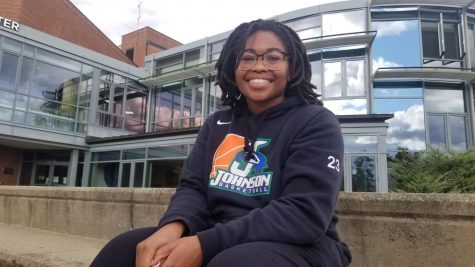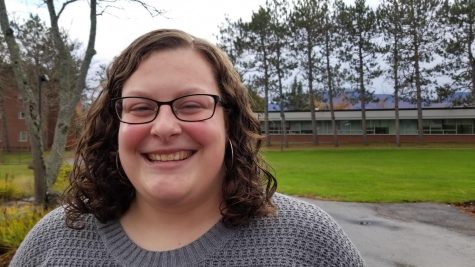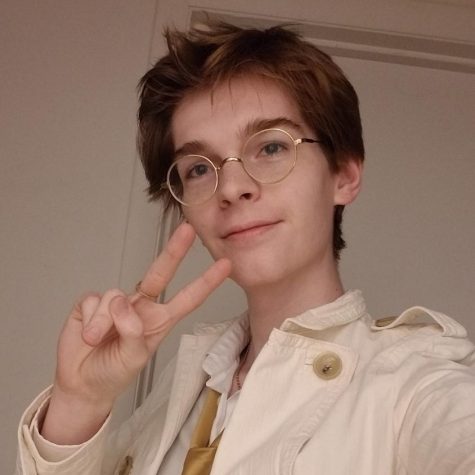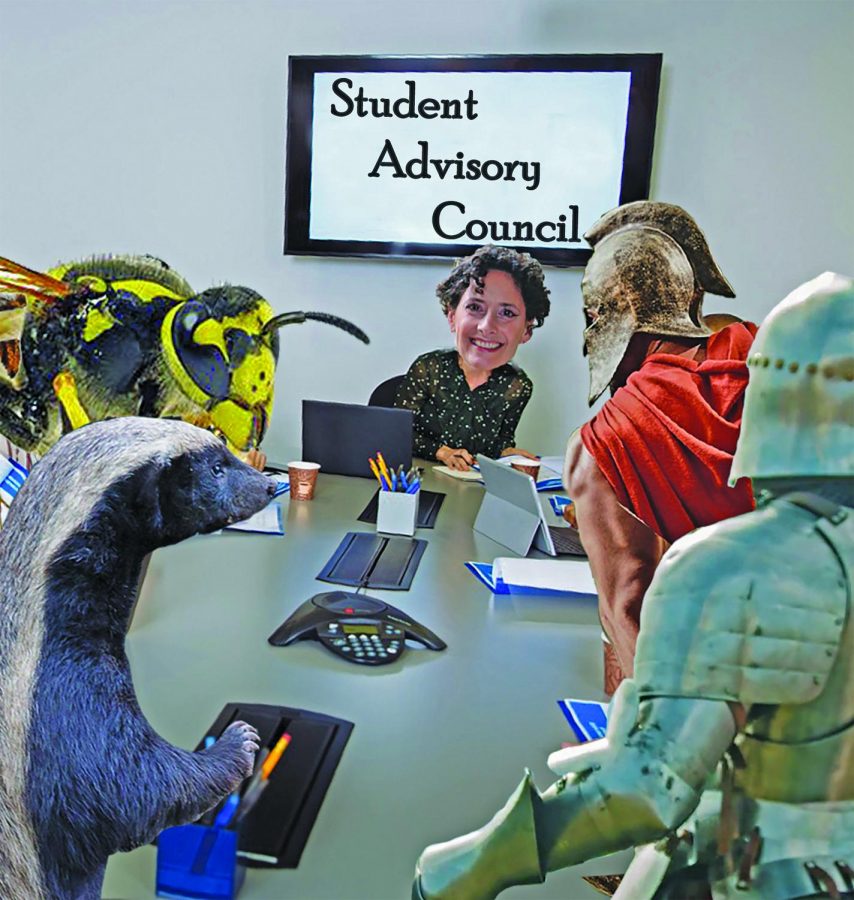Checking in with the new Student Advisory Council
In an effort to hear student voices amidst ongoing transformation, the Vermont State Colleges System has created the student advisory council, comprised of learners from across four residential campuses–which will soon be combined into Vermont State University–as well as from the Community College of Vermont.
“The council is intended to give us the opportunity to really hear from students on the ground about some of the things that we’re doing or we’re planning on doing through the transformation process,” said VSC Chancellor Sophie Zdatny.
Zdatny has been working alongside Wilson Garland, the VSCS director of transformation hired in June, to facilitate meetings with the council and transformation team members.
“We thought it was important to have some way to involve students … but in a way that isn’t too onerous,” Garland said. He said the effort demanded of staff members on the transformation teams would be unrealistic to ask of students, so the council seeks to focus their feedback on certain areas of interest.
Johnson’s representatives
Currently, Northern Vermont University’s Johnson campus has three representatives on the council: Sarina Pesinkowski, Devyn Thompson and Hannah Angolano.
“I wasn’t sure how much student involvement there would be. A lot of students like to gripe about the issues but not make change,” Pesinkowski said. A fifth-year psychology major with a minor on the Lyndon campus, she felt she would have valuable experiences to contribute to the council’s conversations.
Thompson is a junior studying education, and she said she nominated herself as well as received nominations from a professor and a staff member. “My biggest fear was it was going to be an all-white panel,” she said, “and another fear was it’s not going to have a lot of Johnson representation.”
Angolano, also an education major in her third year, said she was likely nominated by a faculty member, as she didn’t do so herself. “I got an email that said that I had been chosen to do the Student Advisory Council, and I thought that it was a better way to have my voice heard from a larger group of people,” she said.
How the council functions
The council meets bi-weekly on Thursday evenings, and the meetings last for 90 minutes. “We try and have a specific area of focus for each of the council meetings,” Garland said. He said the meeting is structured as a series of questions from himself and other transformation leaders, with students giving input as they see fit.
“There are some topics that come up that I know it will be better served by someone else,” Thompson said. “If I’m able to give input, I do, and when it’s not my time, I step back.”
Zdatny said organizing the meeting in this way allows the administration to get specific feedback on certain areas at a time. Garland finds out what the transformation teams need information on, then presents the questions to the council and reports their answers back to the team leaders.
“If you have something to say, you can say it, and if you don’t really feel like you have anything to add to the conversation, you don’t have to add. I just think that’s a really good way to conduct the meetings,” Angolano said.

How it’s going so far
“They really prioritized how each campus handles different things,” Thompson said of the council’s focus. “They care a lot about the structure of the institution, which I really appreciate.” She said some areas of conversation so far have included academic support, admissions and financial aid.
“At the moment, they’re doing a lot of listening, which I’m very appreciative of,” Pesinkowski said. “When they have the answers, they’ve given them to us, and they’ve been pretty transparent about if they don’t actually have the answers to something that we’ve asked.”
Angolano agreed and said, “I do feel like they’re doing a very nice job of actively listening and making sure that things are going to go smoothly,” She added that the administrators are usually good about asking follow-up questions for clarification and making sure everybody who wants to speak gets a chance to.
Zdatny said she understands some of the student frustrations surrounding lack of information. “We’re going through this process, and it would be wrong for us to have the answers,” she said. “We need to get that input from people on the ground.”
While Thompson said the council wouldn’t exist if the administration didn’t truly care, she admitted, “I feel like when I give my input, it goes in one ear and out the other sometimes. … I just wish it was more of a conversation instead of, they ask us a question, we give our input, ‘okay, thank you, next.’
“I’m telling you this, but I want to know more now — what are you going to do with this information? … At the end of the day, I can give all the input in the world, and I don’t have a single say as to what goes on with this new institution. I don’t, and I understand that.”
Garland noted that transformation is still in the early stage of discovery, which is centered around gathering information and input from various sources. “We structure the meetings to be about a specific set of topics, so there’s a certain set of teams that would likely benefit from that input, and then we make sure that those teams get that input,” he said.
Makeup and balance of the council’s representatives
“I feel like there is an overabundance of Castleton students on the council, which I was a little annoyed with,” Angolano said. “There’s three Johnson students, I think there’s one or two Lyndon students, a couple VTC, but it’s a lot of Castleton.”
According to Chancellor Zdatny as of Oct. 21, the representatives number five from Castleton, two from CCV, four from VTC and three each from Johnson and Lyndon. She said the list tends to change depending on whether students are available each week.
“Everybody that’s … on the council has some experience of leadership on their campus,” Pesinkowski said. She herself has been on multiple advisory councils, including one which helped guide the NVU consolidation in 2018.
“When I actually did get on the panel, a majority of it is Castleton, which I figured, but I’m just grateful there’s three of us from Johnson,” Thompson said. “The majority is traditional, on-campus style [students]. We do have a few commuters, and we have a couple people from CCV, which I like.”
Thompson appreciated inclusion of different types of learners, such as in and out of state, as she noted the college experience could be quite different between these groups. “In regard to backgrounds, I would say it’s pretty diverse,” she said. “[Racial] diversity–no, but that’s to be expected.”
Pesinkowski agreed that there seemed to be a disproportionate number of Castleton students but admitted that the council is based on interest. Like Thompson, she noted, “I think there’s only two students of color, and there’s no staff members of color.”
Hearing voices from outside the council
As Thompson and Angolano are both members of the Student Government Association, they each have tabling hours during the week. The two said they take this as an opportunity to field student concerns and bring their views to the Student Advisory Council.
“I do hear things from people that either know I’m on the council or just want to talk about something,” Angolano said. “There’s some things a lot of students don’t know regarding financial aid, like how to deny financial aid, and that’s not stuff that’s made publicly available.”
Thompson similarly tries to hear the voices of her peers and said, “A lot of students are really scared.” She noted that many at Johnson are concerned about their programs changing or athletics being merged. The chancellor has confirmed that currently enrolled students will be able to graduate with their existing majors.
And, while each campus will maintain their own teams, it’s likely that some sports will be cut based on recruitment figures at each of the locations. Thompson said relaying this kind of important information to help dissuade fears is a part of why she enjoys on being on the SGA and now also the council.
Transcripts and transparency
Clarity and information seem to be some of the primary concerns held by many students. “Some of it is in regard to making information more public or easier to access,” Angolano said. She said it applied to specific areas such as financial aid and campus events, but also more broadly. “Easy access is one of the big things that I hear about regarding anything that’s going on.”
Pesinkowski said this is not a new phenomenon. “When I was on the Student Advisory Council here at Johnson with [former] President Collins, one of the main issues was that students feel that there’s a lack of transparency,” she noted, adding that it’s a problem most institutions of higher education face.
In an effort to increase information accessibility, the advisory council plans to post transcripts of their meetings on the VSCS transformation page, which is currently undergoing revisions of its own.
“We’re going to be trying to build a different site where we can put more transformation stuff and make it easier to find,” Zdatny said. So, while transcripts haven’t been posted yet, she “would imagine we’ll put a student advisory council tab or section … so it’s easy to find.”
The chancellor’s transformation update from Sept. 27 acknowledged the need for additional clarity pertaining consolidation efforts such as why and how it is being conducted.

Increasing involvement and joining the council
“I personally struggle to identify what I think would be the most effective way to get more students involved,” Pesinkowski said. “They’ve asked us that question … but if students aren’t interested, I just don’t know what I think would be the best way to get more students involved, unfortunately.”
However, she also said, “I think [the administration] plans on doing more town halls in the future. I think that that was something that worked well in the past for getting people to come in on a smaller, less committed basis.”
Zdatny confirmed this as something she seeks to do more of, and she also mentioned the idea of brown-bag lunches organized by the campus presidents. Students can also submit written comments for the chancellor and board on the VSC transformation page.
“I would encourage people to reach out and provide input,” Garland said. “There’s a lot of good work going on and a lot of hard work, and we all want this to turn out the best we can.”
For students who do wish to become more directly involved with the Student Advisory Council, Zdatny and Garland said the group is still accepting new members.
“If students are interested in participating, [they should] reach out to me or Wilson to share their interest and some background information,” Zdatny said. “We are seeking a well-balanced group, reflective of the many varied experiences and perspectives of our students.”
Emailing Zdatny or Garland would be the easiest way for students to start the process of joining the council. Meetings are held on Thursdays from 6-7:30 p.m. The full list of upcoming dates is Oct. 28, Nov. 18, Dec. 9 and Jan. 27. Additional meetings for the spring semester are planned but not currently scheduled.
“We want to open it up just as broadly as possible,” Zdatny said, adding that a having a wide breadth of voices is essential to understanding how different types of students interact with the VSCS.
Currently, all of NVU-Johnson’s representatives are traditionally aged students who live on campus. Having the perspectives of adult learners and commuters would be a valuable addition to the school’s presence on the council.
The level of commitment requested of the council members is intentionally kept low. Students are not expected to do work for the council outside of attending meetings, and both Zdatny and Garland said it’s okay for members to miss one or two if they have other responsibilities.
“Students have other commitments, and we have to be realistic about what kind of time they can spend,” Garland said. “We spend most of the time listening, and we always try to end on time, because it’s important not to be too burdensome on folks that are attending.”
As transformation proceeds past the discovery phase and into design, student input will be essential to shaping a Vermont State University which prioritizes its learners’ success and enrichment.
Looking to the future
“I do hear things from people that either know I’m on the council or just want to talk about something,” Angolano said. “I’ve been here long enough that people are comfortable [saying], ‘hey, can I give you some input,’ or ‘can you do something with this? I don’t know where to go.’”
Each of the representatives realize they will not be benefiting from the transformation. When the new university launches in autumn 2023, each of them will have likely graduated. However, they all hope that their input will improve the upcoming institution for the students who will be a part of it.
“I would like to see the colleges, when they merge, be better for everybody,” Pesinkowski said, adding, “It’s bittersweet, because it would be great to see all these lovely changes that we talked about work for me, but they won’t … I won’t be here for it, so I’m doing what I can while I’m still here.”
Thompson shared a similar sentiment. “All I can do is give the best advice possible to help the students who are going to be here for this merge,” she said. “Even though I’m not going to be there to see it, I don’t want to graduate knowing that the underclassmen that I have made connections with here … are going to suffer and be miserable because we didn’t step up and help.”
As the Johnson campus has experienced unification already, many of its students have expressed fatigue at the upcoming system-wide transformation, but it also comes with increased awareness of what works and what doesn’t when merging multiple institutions.
“There’s still a lot of things between just Johnson and Lyndon — just two campuses — that have not been streamlined, have not been fixed, have not found common ground,” Pesinkowski said. “That concerns me going forward, and I think that’s one of the reasons I was so interested in getting involved.
“I think, a merger is a messy thing. It can go well, and it certainly has benefits, but it also can be messy and can take a lot of time. Anything that students and faculty can do to make that experience and transition easier for all of us, as a community, is wise.”

Senior, Creative Writing
From Fletcher, VT
Spring 2020-Present
"Call me mommy and I'll bring you blankets and hold you while you cry."



